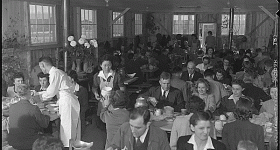The drive from San Francisco to Manzanar is long even on contemporary highways driving 65 miles per hour, and in winter, it’s still longer when one needs to skirt the Sierras to the south. This location would have been even more remote in the 1940s, when Elaine Black Yoneda lived there with her husband, Karl Yoneda, and their son, Tommy.
I went to Manzanar to photograph the site as part of an artist’s commission that featured socially active but historically underrepresented San Francisco Bay Area Jewish Americans. The story of Elaine Black Yoneda, a Communist labor activist born in 1906, begins in a manner typical of many Eastern European Jewish immigrants. She was raised by well-educated, working-class parents who came to America seeking economic opportunity and freedom from religious persecution, and was regularly exposed to radical thought that shaped her criticisms of capitalism and abuses of workers. As she reached adulthood, however, her story departed from this stock narrative, first through her marriage to a Japanese American, and then as a Jewish woman living in a camp during World War II — but not a concentration camp in Europe; rather, a Japanese internment camp in California.
Sparks were in the air between Elaine and Karl from the moment they met in the Communist Party office in Los Angeles in 1930. They moved in together in San Francisco in 1933, but California anti-miscegenation laws barred their marriage, and they faced severe housing discrimination, turned away by landlords fearful of renting to an interracial couple.
But, as was true for many radicals of their time, they eschewed social conventions including ethnic, religious and legal strictures on their relationship. If it had been up to Karl and Elaine, they would never have married — a marriage license “wasn’t going to do anything for me and Karl,” Elaine said. When Elaine faced legal charges for her involvement with a free speech protest in Dolores Park in 1935, her lawyers advised that her cohabitation with Karl could be used against her. Elaine and Karl took a brief trip to Washington state, where interracial marriages were legal, and returned to San Francisco as husband and wife.
Following the Japanese attack on Pearl Harbor, Karl was soon out of work. On March 23, 1942, he joined approximately 1,000 Japanese American voluntary evacuees who were all told they could find work constructing a relocation camp in Manzanar, CA, near a small town called Independence on the eastern side of the Sierras. A month prior, President Roosevelt signed Executive Order 9066 authorizing the relocation of Americans of “enemy foreign ancestry,” and camps needed to be built. Karl willingly went to Manzanar, but on his arrival, he quickly learned that he was not an employee. He later wrote in his memoir, “I was among the multitude who did not realize the significance of Executive Order 9066.”
Elaine soon received notice that their 2-year-old son Tommy also needed to report to Manzanar — anyone of as little as one-sixteenth Japanese descent was to be interned, a guideline disturbingly reminiscent of the “one-drop” rules that applied to blacks during the era of their American enslavement, and also of Nazi Germany’s contemporaneous laws used to determine Jewish ancestry.
Elaine insisted on accompanying Tommy because he suffered from chronically poor health. She was not the only non-Japanese to live in a Japanese internment camp during WWII — a small number of friends and family voluntarily joined Japanese Americans to express loyalty and support.
Throughout this time, Karl attempted to enlist in the US Army, a common move among Nisei who sought to demonstrate their patriotism. As Communists, both Karl and Elaine believed that the most urgent matter was to fight Fascism in Europe, and they supported the American war effort genuinely. In November 1942, Karl was accepted into the military.
Online exclusive: Read more about the violence the couple faced during their imprisonment and the little-known story of a gang at Manzanar, the Black Dragons
Read the full text of this story in Issue 25: The Generation Issue, available now. Subscribe to Hyphen or pick up a copy at a newsstand near you.









Comments